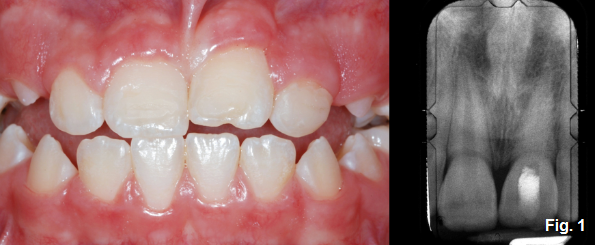Typically when managing ankylosed teeth in children it is advisable to remove the ankylosed tooth prior to significant growth cycles so growth and subsequent eruption of teeth don’t create significant hard and soft tissue defects. However, the difficulty in managing these patients is providing interim tooth replacement until the cessation of growth. This is especially true in males when trauma occurs early in life (ie. age 9 to 11) and where growth may not be completed until 21 to 22 years of age.

This can be a considerable amount of time to manage the edentulous ridge and provide an interim restoration that doesn’t significantly impact them socially. The main image shows a 10-year-old male patient with an ankylosed tooth #9 that is beginning to show signs of incisal edge and gingival margin asymmetry.
Anklyosis and Autotransplantation
One option that I have previously written about is the use of autotransplantation to manage these young patients. Autotransplantion is a procedure that utilizes the patient's own teeth, typically the mandibular second premolar, as a replacement for missing anterior teeth by extraction and re-implantation. The transplanted tooth can then serve as an esthetic and functional replacement for the patient. The major concern for most dentists is: how predictable is this type of treatment?

A 2002 paper from the Am J Orthod Dentofacial Orthop (Czochrowska EM, et al.) entitled Outcome of Tooth Transplanation: Survival and Success Rates 17-41 Years Post-treatment showed a 90% survival rate (with a mean observation time of 26 years). By comparison with other treatment options, this is an extremely favorable outcome. However, it must be stated that the success rates is highly dependent on the skill and experience of the surgeon performing transplantations. I have been fortunate to work with Dr. Jim Janakievski in Tacoma, WA whom I consider to be one of the world experts in the area.
The Requirements Needed for Autotransplantation?
The harvested tooth needs to have a root length that is two-thirds to fully developed and have an open apex. This will provide the most predictable transplant for retaining vitality as well as having continued root development. Generally, the patient that has a mandibular second premolar that meets these criteria is typically between the ages of 10-12. (Figure 2)

Hence, this treatment option has a narrow window of time where it is viable. The transplanted teeth placed in a similar position of eruption as they were in when harvested. (Figure 3) These teeth typically have continued root development and even maintain their vitality which can be attributed to their stage of root development at the time of harvest.

The transplant tooth can be built up with composite and the patient can continue on with orthodontic treatment. (Figures 4 and 5)

Although this is not a treatment option that needs to be utilized every day, it is wonderful to know that autotransplantion can provide a predictable esthetic and functional replacement for these patients that would otherwise have to wait 10 to 12 years, until the completion of growth, before the implant can be placed.

Comments
February 9th, 2015
February 10th, 2015